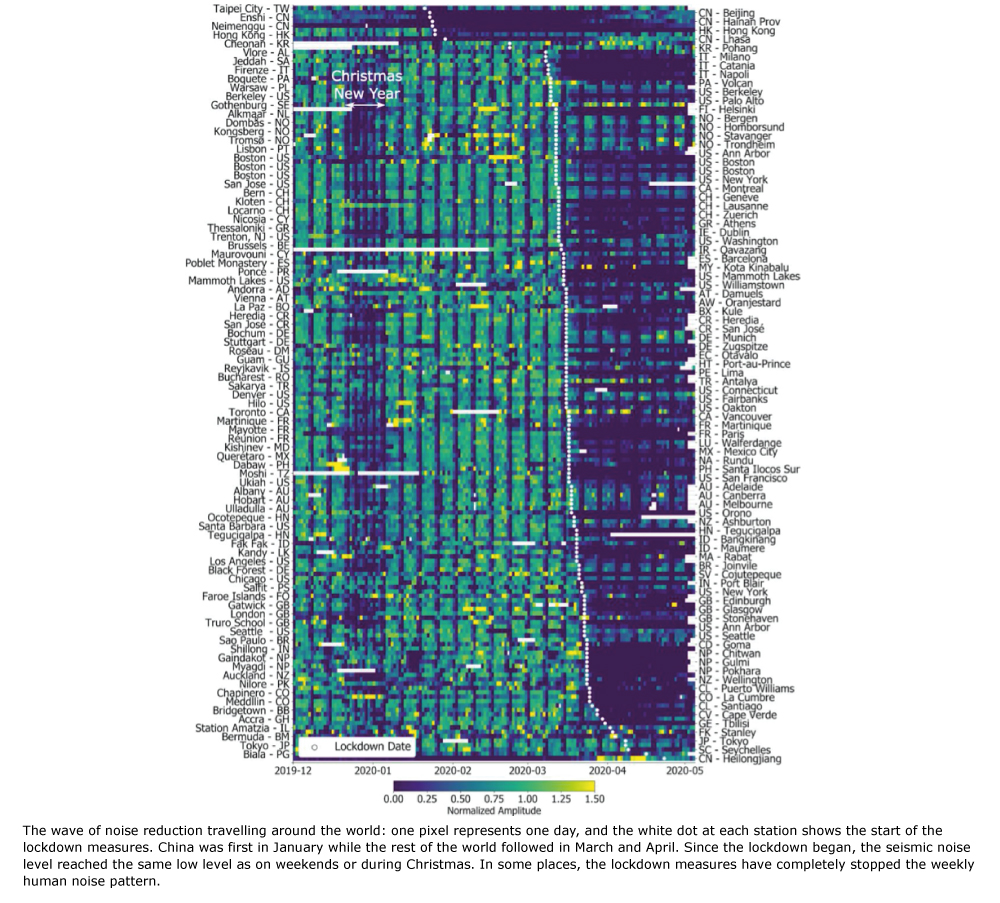2020-07-24
COVID-19 pandemic reduces seismic noise worldwide
Research recently published in the journal Science has shown that lockdown measures to combat the spread of COVID-19 lead to a 50% reduction in seismic noise observed around the world in early to mid-2020. In Switzerland, researchers from the Swiss Seismological Service (SED) at ETH Zurich were also able to identify this phenomenon, as the SED announced in an earlier news item in April 2020. The SED, therefore, participated in the international study, in which a total of 76 authors from 66 institutions in 27 countries collaborated.
Read more...By analysing month-to-years long datasets from over 300 seismic stations around the world, the study, led by Dr Thomas Lecocq from the Royal Observatory of Belgium, was able to show how the seismic noise decreased in many countries and regions since the start of the lockdown measures. The researchers could visualise the resulting "wave of quiet” moving through China, then to Italy, and around the rest of the world. The seismic lockdown sees the total effect of physical and social distancing measures, reduced economic and industrial activity and drops in tourism and travel. The 2020 seismic noise quiet period is the longest and most prominent global anthropogenic seismic noise reduction on record.
Traditionally, seismology focuses on measuring and analysing seismic waves arising from earthquakes. High-frequency vibrations (“buzz”) of human activity, however, contaminate the seismic records from natural sources. Walking around, driving cars, and getting the train, but also heavy industry and construction work generate unique seismic signals in the subsurface that influence the recordings of natural phenomena. The strongest seismic noise reductions from the COVID-19 lockdown were found in urban areas, but the study also observed signs of the lockdown on sensors installed hundreds of meters below the surface and in more remote areas, such as in sub-Saharan Africa. Furthermore, the researchers found a strong correlation between seismic noise reduction and human mobility datasets.
In Switzerland, in particular the stations belonging to the Swiss Strong Motion Network (SSMNet) did show similar effects. Many of these measuring stations are located in urban areas and a significant reduction in seismic noise was recorded in Lugano, Martigny, Zurich, Basel and Geneva, among others. Since the lockdown was declared in mid-March, levels of seismic noise in these towns and cities have been nearly as low on working days as they were during weekends before the lockdown began. Meanwhile, the seismic noise is back to almost normal levels in Switzerland and in most countries analysed in the study.
Will the 2020 seismic noise quiet period allow new types of signals to be detected? The study has shown the first evidence that previously concealed earthquake signals, especially during the daytime, appeared much clearer on seismic sensors in urban areas during the lockdown. In Switzerland, the overall effect is a decrease in the detection threshold for earthquakes by about 0.1 - 0.2 magnitude units across the country, for many urban areas this decrease is even greater at 0.3 magnitude units or more.
SED seismologist Dr Frédérick Massin, one of the co-authors of the study, says that the researchers hope that their work will spawn further research on the seismic lockdown. Finding previously hidden signals from earthquakes and volcanoes will be one key goal. Due to the growing urbanisation and increasing populations, it becomes more important than ever to characterise the anthropogenic noise humans cause so that seismologists can better listen to the Earth, especially in cities, and monitor the ground movements beneath our feet.
More information: https://science.sciencemag.org/lookup/doi/10.1126/science.abd2438
